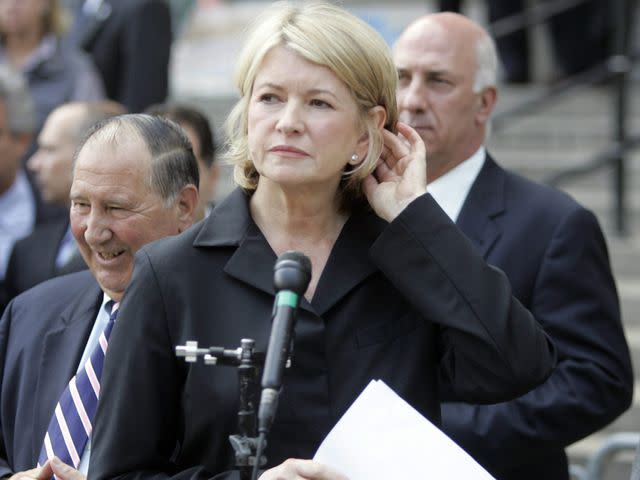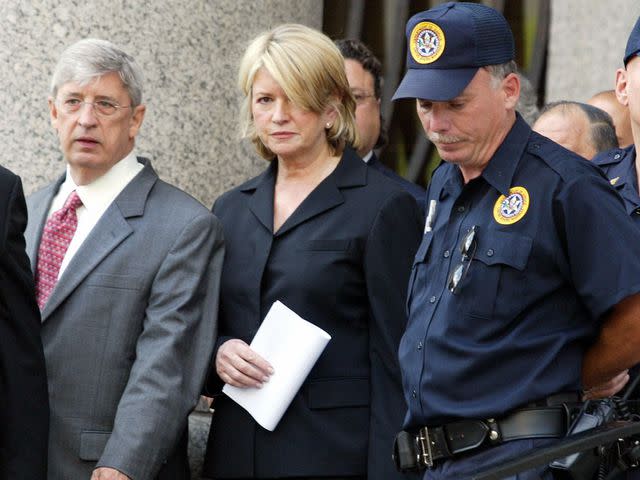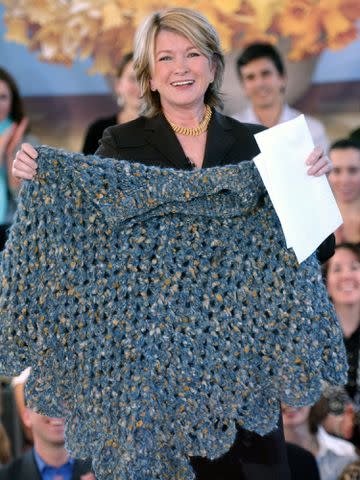Why Did Martha Stewart Go to Prison? A Look Back at Her 2004 Fraud Case
- Oops!Something went wrong.Please try again later.
The lifestyle icon spent five months in prison for lying to investigators about a stock trade

Spencer Platt/Getty
Martha Stewart exits court after the sentencing phase of her conviction on a stock-trading scandal on July 16, 2004 in New York City.Martha Stewart has been many things in her lifetime: A best-selling author, a successful entrepreneur, an Emmy-award-winning television host — but in 2004, she spent five months behind bars for lying about a stock trade.
Stewart’s legal troubles began more than two decades ago when her career was at its peak. Her media empire, Martha Stewart Living Omnimedia, had gone public in 1999, making Stewart the first female self-made billionaire in the U.S. A few years later, however, Stewart found herself wrapped up in an insider trading scandal that would eventually send her to prison.
Stewart landed in hot water after selling her stake in ImClone Systems, a biopharmaceutical company, in December 2001. When investigators questioned her on the trade in early 2002, she and her stockbroker, Peter Bacanovic, maintained that they had no insider info that prompted the sale. However, federal prosecutors later accused Stewart (who was once a stockbroker herself) and Bacanovic of acting on non-public knowledge when they made the trade — and then lying about it to the feds.
A highly publicized trial ensued in early 2004, and Stewart was found guilty on charges including conspiracy and obstruction of justice. She was sentenced to five months in prison and two years of probation — leaving the future of her company and her reputation uncertain.
But despite the negative press and her stint behind bars, Stewart rebounded. She kept her company intact, wrote a book and debuted two new television shows within less than a year of her release from prison in March 2005 — and hasn’t slowed down since. (She’s still posting Instagram thirst traps at 82 years old.)
So, how did Stewart survive the stockbroking scandal and come out stronger on the other side? The global icon attributes her post-prison success to her refusal to let her time in jail define her.
Related: Martha Stewart's Life in Photos
“One thing I do not ever want is to be identified or I don’t want that to be the major thing of my life,” she told Katie Couric in 2017. “I was a strong person to start with and thank heavens I was and I can still hold my head up high and know that I’m fine.”
Stewart’s resiliency throughout the highs and lows of her life is the subject of a new CNN miniseries, The Many Lives of Martha Stewart, which premieres on Jan. 28. The four hour-long episodes will chronicle her “explosive rise to success, her staggering fall from grace, and her momentous comeback to the limelight,” according to a release, and feature interviews with Stewart’s past employees, former inmates, fellow chefs and loved ones.
But first, here’s a look back at all the details of Martha Stewart’s fraud case — from the trade that caused all the trouble to her epic post-prison comeback.
What was Martha Stewart accused of?

Peter Foley/EPA/Shutterstock
Martha Stewart at Manhattan Federal Court on March 1, 2004. ; Peter Bacanovic exits Manhattan Federal Court on March 5, 2004 in New York after the verdict was announced in the Martha Stewart trial.In June 2003, Stewart faced both criminal and civil charges related to her December 2001 sale of nearly 4,000 ImClone shares.
On June 4, 2003, the SEC filed a civil lawsuit against Stewart and her stockbroker, Bacanovic, alleging that the two committed securities fraud by participating in illegal insider trading. The same day, a federal grand jury indicted Stewart on nine counts of securities fraud, making false statements and obstruction of justice, The New York Times reported.
The charges stemmed from a stock trade that occurred on Dec. 27, 2001. According to the federal indictment, Bacanovic was informed by his assistant, Douglas Faneuil, that the CEO of ImClone, Sam Waksal, was selling off the majority of his shares after learning that the FDA intended to reject Erbitux, a cancer drug developed by the company. As a result, Bacanovic allegedly instructed Faneuil to inform Stewart that Waksal was dumping his shares.
Faneuil left Stewart a phone message (which Stewart allegedly later tried to erase) that stated, “Peter Bacanovic thinks ImClone is going to start trading downward,” per The New York Times. After speaking with Faneuil, Stewart allegedly requested that he sell her stake in ImClone, which was just under 4,000 shares.
In the months following the questionable trade, Stewart and Bacanovic claimed that they had made a prior agreement to sell her ImClone shares if the stock price ever fell below $60. However, congressional investigators found no record of a stop-loss order between Stewart and Bacanovic, according to Newsweek.
“This criminal case is about lying — lying to the F.B.I., lying to the SEC, lying to investors,” James Comey, then the United States attorney for the Southern District of New York, said at a news conference when announcing the charges, per The New York Times. “Martha Stewart is being prosecuted not for who she is, but because of what she did.”
How much did Martha Stewart make from selling her ImClone shares?

James Devaney/WireImage
Martha Stewart in New York City on June 2, 2004.Stewart had 3,928 shares in ImClone, according to the SEC's complaint. When she sold her stake on Dec. 27, 2001, the shares cashed out at approximately $227,000, The New York Times reported — netting Stewart a profit of about $51,000 from the sale, according to ABC News.
On Dec. 28, 2001, the day after Stewart sold her shares, the FDA announced that it had rejected ImClone’s application for the approval of Erbitux. By the next day of trading, ImClone’s stock dropped 16 percent — from $60 per share to $46 per share, according to an SEC release at the time. The SEC alleged that Stewart avoided losses of more than $45,000 by selling her stake when she did.
What was Martha Stewart convicted of?

Andrew Gombert/EPA/Shutterstock
Martha Stewart speaks outside the Manhattan Federal Court after sentencing on July 16, 2004.Following a six-week trial in early 2004, Stewart was found guilty of conspiracy, obstruction and two counts of lying to federal investigators. However, the most serious criminal charge against her — securities fraud — was previously dismissed by the judge.
Prosecutors had alleged that Stewart committed securities fraud when she lied about why she sold her ImClone stock. They claimed that her false statements were made in an effort to maintain her innocence and bolster the stock price of her own company, Martha Stewart Living Omnimedia, The New York Times reported. The securities fraud charge would have carried a maximum penalty of 10 years in prison and a $1 million fine, according to CNN Money.
Two years after her criminal trial, in August 2006, Stewart also settled with the SEC over the civil insider trading charges against her — bringing her legal saga to an end. Stewart agreed to pay $195,000 in fines and penalties, according to The New York Times, and was barred from serving as a director or chief executive officer of any public company for five years.
How long was Martha Stewart in prison?

DON EMMERT/AFP/Getty
Martha Stewart leaves the Manhattan Federal Court after being sentenced on July 16, 2004.Stewart was sentenced to five months in prison, in addition to five months of home confinement and two years of supervised probation.
“I'll be back. I will be back,” she said outside of the courthouse following her sentencing, per The New York Times. “I’m used to all kinds of hard work, as you know, and I’m not afraid. I’m not afraid whatsoever.”
The chef and entertainer checked into a minimum-security federal correctional facility in Alderson, West Virginia, on Oct. 8, 2004. She served the full five months and was released on March 4, 2005, per CNN. Stewart then returned to her home in Bedford, New York, where she completed her five months of house arrest.
“The experience of the last five months in Alderson, West Virginia, has been life altering and life affirming,” Stewart said in a statement on her website on the date of her release. “Someday, I hope to have the chance to talk more about all that has happened, the extraordinary people I have met here and all that I have learned.”
She continued, “Right now, as you can imagine, I am thrilled to be returning to my more familiar life. My heart is filled with joy at the prospect of the warm embraces of my family, friends and colleagues. Certainly, there is no place like home.”
What has Martha Stewart said about her time in prison?

Carvalho/FilmMagic
Martha Stewart during a press conference on March 7, 2005.Stewart was able to share her initial thoughts on prison life shortly after she was first incarcerated. On Oct. 18, 2004, she released a statement on her website about how she was settling in — and likened the prison to a “college campus.”
“The camp is fine; it is pretty much what I anticipated,” she wrote. “The best news – everyone is nice – both the officials and my fellow inmates. I have adjusted and am very busy. The camp is like an old-fashioned college campus – without the freedom, of course.”
In the years since her release from prison, Stewart has opened up more about the highs and lows she experienced while serving her five-month sentence.
Stewart revealed to PEOPLE in November 2020 that she spent her time in prison revisiting old hobbies, like ceramics, and cultivating new ones, including crocheting.
“Even when I went away [to Alderson Federal Prison Camp in West Virginia] for five months, I got through it,” she shared. “I learned how to crochet. I still have the gorgeous crocheted poncho [that I wore leaving prison]. It’s in the attic. And I reupped my ceramics there. I had done a lot of ceramics as a child, and we had this fabulous ceramics studio in West Virginia, and I made an entire crèche scene. That’s my best memory.”
Not all of Stewart’s memories from prison are fond, however. She opened up on Couric’s self-titled podcast in 2017 about her time spent behind bars, calling it “a horrible experience.”
“It was horrifying and no one, no one, should have to go through that kind of indignity really except for murderers, and there are a few other categories, but no one should have to go through that,” she told Couric about prison. “It’s a very, very awful thing.”
Stewart continued, “There are lots and lots of disturbing things that go on in an incarceration like that.”
The experience is one that made the lifestyle media guru “stronger,” though, Stewart revealed to Harper’s Bazaar in November 2021.
“I knew I was strong going in and I was certainly stronger coming out,” she said. “It was a very serious happening in my life. I take it very seriously. I’m not bitter about it.”
What has Martha Stewart done in the 20 years since her release?

Gotham/FilmMagic
Martha Stewart at the 2023 'Sports Illustrated Swimsuit' issue launch in New York City.Stewart staged her comeback almost immediately following her release from prison in March 2005.
She returned to television in September 2005 with two shows: The Martha Stewart Show, a daytime talk show, and a spin-off of Donald Trump’s reality show called The Apprentice: Martha Stewart. Though her iteration of The Apprentice was short-lived (it was canceled after one season, according to Forbes), her talk show was much more successful — it ran from 2005 to 2012 and won Stewart three Daytime Emmy Awards.
Following the end of The Martha Stewart Show, Stewart hosted a cooking show on PBS, titled Martha Stewart Cooking School, from 2012 to 2017. She has also appeared as a guest host on Food Network’s Chopped, hosted her own Food Network competition show called Bakeaway Camp with Martha Stewart, had an HGTV show titled Martha Knows Best and developed and hosted three shows for Roku Channel (Martha Cooks, Martha Gardens and Martha Holidays).
Stewart also developed a friendship with rapper Snoop Dogg in her post-prison life. The “odd couple,” as Stewart has described them, first met when he appeared on her daytime talk show in 2008. From there, the two formed an unlikely bond that was both personal and professional, with Stewart and Snoop even hosting two celebrity cooking shows for VH1: Martha & Snoop’s Dinner Party and Martha & Snoop’s Potluck Party Challenge.
Related: Martha Stewart and Snoop Dogg's Friendship Timeline
Stewart’s post-prison success hasn’t just been limited to television, however: She’s since published 43 more books, developed a line of CBD products and sold her multimedia empire, Martha Stewart Living Omnimedia, for $353 million in 2015, Forbes reported. She also made history in May 2023 when, at 81 years old, she became the oldest woman to appear on the cover of Sports Illustrated Swimsuit issue.
“There’s no reason to retire,” Stewart told PEOPLE in May 2023. She also squashed the idea of slowing down or taking time off.
“That’s not what my life is about,” she said. “My life is about doing things and learning things and teaching things.”
For more People news, make sure to sign up for our newsletter!
Read the original article on People.

